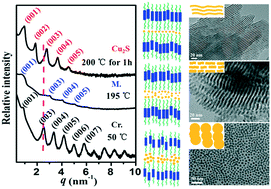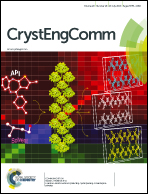Probing into dimension and shape control mechanism of copper(i) sulfide nanomaterials via solventless thermolysis based on mesogenic thiolate precursors†
Abstract
Nanostructured materials of various shape and dimension have aroused intensive interests, among which copper(I) sulfide (Cu2S) nanomaterials are of particular prominence. In this work, various nanostructured Cu2S have been facilely prepared via solventless thermolysis, with well-controlled shape and dimension determined by and inherited from the layered structures of the azobenzene-containing single-source copper thiolate mesogenic precursors. The precursors with longer alkyl tails exhibit highly ordered layered liquid crystalline mesophases and retain persistent order up to temperatures beyond the clearing points. Under non-vacuum inert atmosphere or with further elevated temperature, large undulations of the constrained lamellar space result in significantly enhanced diffusion, migration and mass transfer, thus leading to the morphologies changing from one-dimensional (1D) ultrathin nanowires into thickened nanorods then to discrete 2D nanodisks. Based on a variety of modern techniques, especially in situ variable-temperature small angle X-ray scattering (SAXS), an extended universal “layered-precursor to lamellar-nanomaterial” (LPLM) mechanism has been proposed to account for the structural evolution of Cu2S nanomaterials. Our findings provide a novel pathway with clearer mechanism for well-controlled preparation of metal chalcogenides of various dimension and shape. In particular, the ultrathin Cu2S nanowires are anticipated to serve as fascinating semiconducting materials for various promising device applications.



 Please wait while we load your content...
Please wait while we load your content...